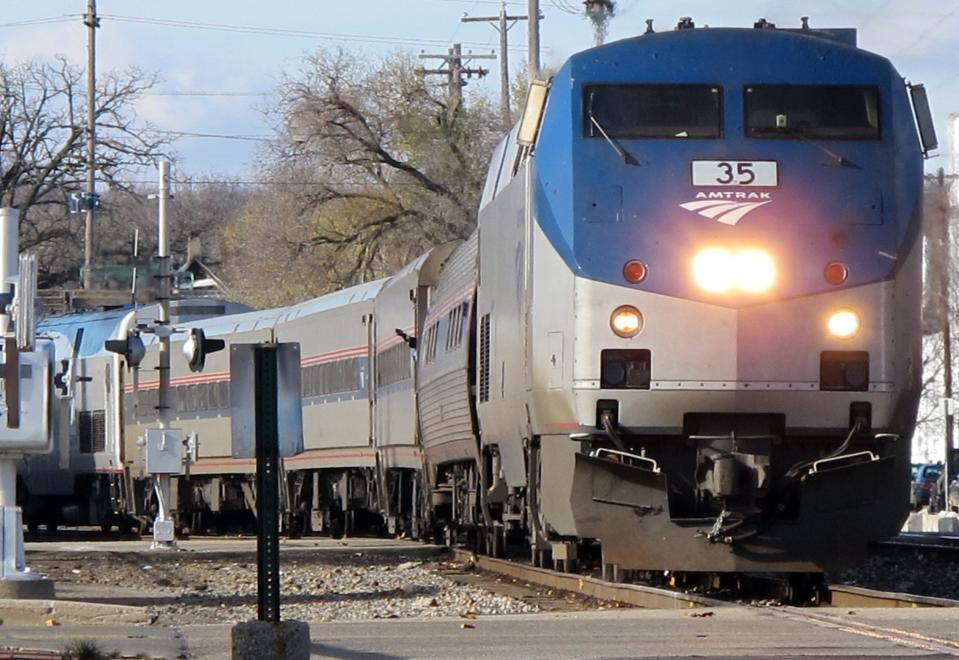How to take the train in Michigan: Amtrak ticket prices, lines, amenities
Windshield time is wasted time.
That's what Amtrak Chicago's senior public relations manager Marc Magliari believes, along with thousands of others across the country who prefer riding a train to get to where they need to be.
“Have you driven I-96 lately? Driving is increasingly less fun. Whether it’s someone on your bumper yapping on their phone, next to you putting makeup on or on the other side of you shaving, there’s people who do all sorts of things that they shouldn’t do while driving," said Magliari. "But almost everything that you can’t do driving, you can safely do on a train.”

Over the past several years, said Michigan Department of Transportation’s rail communications Manager Michael Frezell, there have been numerous updates to Michigan railways. Those include infrastructure improvements for safety and speed on the track between Kalamazoo and Dearborn, railroad bridge replacements in Jackson, new locomotives and passenger cars, and new stations in Dearborn, Troy/Birmingham, Pontiac, East Lansing, and Grand Rapids.
And they only plan to continue progressing the passenger experience.
Over the next 10-15 years, Amtrak has big plans to expand the railways across the country, including a proposed route extension that would connect Detroit to the line currently running from Cleveland to Toledo, with a stop at the Detroit Metropolitan Airport in Romulus, and increased speeds and daily roundtrips on existing Michigan lines.
MDOT has another proposal underway to turn Detroit's Amtrak station in the New Center area into the Detroit New Center Intermodal Facility, which would combine the existing railway station with a station for intercity bus carriers.
These railway improvements, combined with frustrating driving conditions and recent plane mishaps, make a peaceful train ride sound more and more like a better option.
Here's what to know if you're ready to hit the railroad.
Train lines
Three train lines are operating in Michigan:
The Pere Marquette connects Chicago to Grand Rapids, including stops in St. Joseph (near Benton Harbor), Bangor, and Holland.
The Blue Water connects Chicago to Port Huron, with stops in New Buffalo, Niles, Dowagiac, Kalamazoo, Battle Creek, East Lansing, Durand, Flint, and Lapeer.
The Wolverine connects Chicago to Pontiac, with stops in New Buffalo, Niles, Dowagiac, Kalamazoo, Battle Creek, Albion, Jackson, Ann Arbor, Dearborn, Detroit, Royal Oak, and Troy. A stop in Windsor, Ontario, will soon be added to this line.
More: Amtrak Detroit-Chicago route to expand to Windsor
To travel to cities further north than the train lines run, you can extend your journey on an Amtrak Thruway bus. Rides on Thruway buses are purchased when scheduling your train trip; for example, if you're trying to make your way from Detroit to Mackinaw City, you'd enter those cities as the departing and arriving stations respectively and pay for a mixed service ticket. For many of Michigan's northern bus stops, you'll take the train to Kalamazoo and then board the bus to your final destination.
Additionally, if you're looking to travel outside of Michigan, you'll have to commute to the station in Toledo or take the train to Chicago – a big Amtrak hub – and then on to your final destination.
The Amtrak website has an interactive map tool to help you figure out which routes and lines to take from your starting point to your desired endpoint.
Tickets & prices
The cost of Amtrak tickets varies based on route, distance, coach or business class, and time of year, as well as any applicable discounts, like military, child, student, or senior discounts. Prices increase accordingly with the amount of distance traveled, with distances as short as the nine miles between Detroit and Dearborn being as inexpensive as $6.
Amtrak also offers group travel discounts for groups of 15 or more, as well as multi-ride and rail passes.
Like flights, it's recommended that travelers book their tickets a few weeks ahead of time to avoid higher prices as the trains fill up. Magliari also said that fares are often cheaper on weekdays – particularly Tuesdays – than on weekend days.
Tickets can be purchased at amtrak.com, by calling 800-USA-AMTRAK (1-800-872-7245), by visiting a staffed station with a ticket sales office or on the Amtrak mobile app.
More: Infrastructure bill's rail funds may help Michigan train travel ideas
Amenities
Michigan's Amtrak lines offer coach and business class seat options. On the train, they have café car to purchase a small meal, snack or beverage, a "quiet" car if you're looking for silence, Wi-Fi, and outlets onboard.,
In terms of luggage, travelers can bring up to one personal item and two carry-ons totaling 125 pounds for free. However, the Michigan lines do not offer checked baggage.
Bicycles, golf clubs, and pets are allowed onboard for an additional cost.
What to do on the train
Before even boarding the train, plan to get to the train station at least 30 minutes before your departure time, and be sure to bring your ID.
When you board the train, conductors might point you in the direction of a particular car to sit in, but it's otherwise open seating. Once the conductors have checked your tickets, you're free to roam into other cars. Just be sure to listen to the announcements so you don't miss your stop.
Otherwise, just sit back, relax, and let the landscape roll by.
This article originally appeared on Detroit Free Press: How to ride train in Michigan: Amtrak ticket prices, lines, amenities

